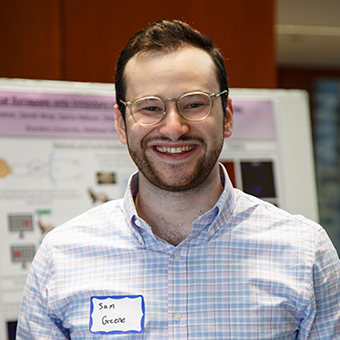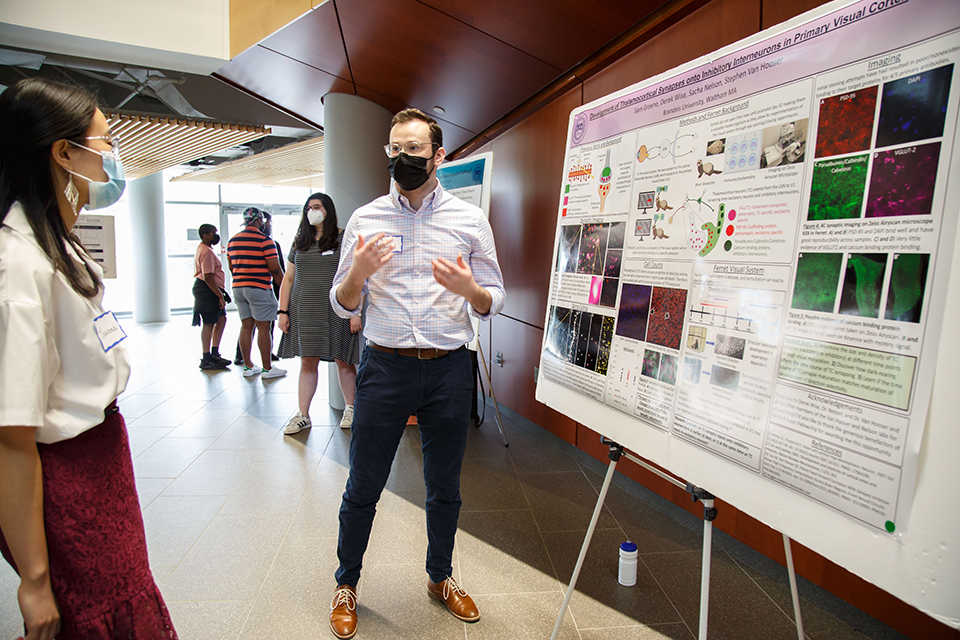Sam Greene
Van Hooser Lab
Department of Biology
Brandeis University
Development of Thalamocortical Synapses onto Inhibitory Interneurons in Primary Visual Cortex
 Decades of research have identified important properties of the visual system; those being ocular dominance, direction selectivity and orientation selectivity. Feedforward excitation and inhibition are implicated in the development of the visual system through the growth and maturation of synaptic connections between the lateral geniculate nucleus (LGN) and primary visual cortex (V1). It is well established that visual experience is necessary for development of direction selectivity.
Decades of research have identified important properties of the visual system; those being ocular dominance, direction selectivity and orientation selectivity. Feedforward excitation and inhibition are implicated in the development of the visual system through the growth and maturation of synaptic connections between the lateral geniculate nucleus (LGN) and primary visual cortex (V1). It is well established that visual experience is necessary for development of direction selectivity.
This makes ferrets, which do not open their eyes until postnatal day 32, a valuable model organism as they allow for experimentation of the visual system through eye opening/closing experiments. Thalamocortical (TC) neurons mature from the LGN and extend into V1 synapsing onto excitatory neurons and inhibitory interneurons. The precise delivery of feedforward excitation followed by delayed inhibition can result in temporally precise post-synaptic action potentials which may be important to the development of direction selectivity upon eye opening. My research aims to identify the time course of the development of feedforward synapses onto inhibitory interneurons compared to excitatory cells. I will record the density and size of synapses onto inhibitory interneurons at varying times through visual development and investigate the effects of dark-rearing on the development of these synapses.
This could have major implications on the increase in direction selectivity upon eye-opening; it could reveal the effects of these inhibitory interneurons in refining the developing circuitry and or any significance of its delayed inhibitory delivery. Super-resolution imaging allows colocalization of pre- and post-synaptic protein signals by confocal microscopy even through thick slices of tissue. I use postmortem slices of brain tissue and stain for specific proteins marking the pre- and post-synapse and inhibitory interneurons. Current work is being done to refine the staining protocol. This research will enhance our understanding of V1 development and determine the significance of TC synaptic development onto inhibitory interneurons.
Personal Statement
Working in the Van Hooser Lab for the second summer in a row has been such a special and rewarding experience. I joined the lab during the height of the pandemic (February 2021) as a second-semester Sophomore. Starting as a remote researcher and then transitioning to in-person lab research during the summer of 2021 was daunting at first, but was something I quickly adapted to and really enjoyed. Fast forward to now, spending my second summer in the lab, I feel extremely comfortable and a true member of the lab. On top of seeing huge improvements in my wet-lab skills, this summer has allowed me to engage socially with my fellow lab members whether that be fellow undergraduate students or graduate students. I have made new friends and gained mentors who help me and offer me advice on my science journey. This whole experience has allowed me to truly appreciate the research setting as I was able to be fully devoted to my research. I have spent this summer learning and refining a staining protocol, adapting it to work on ferrets rather than mice. I have begun a deep dive into the literature surrounding my project and am focusing on learning how vision develops in ferrets.
This summer has forced me out of my comfort zone as I begin my senior thesis project. I have had to develop a greater sense of independence as I begin work on my own project. My problem-solving capabilities have improved immensely, allowing me to rationalize and implement solutions rather than turning to my mentors to solve my problems. I have been able to split my time between working on my own project and helping my mentor as he wraps up his own thesis. I have been able to transfer a lot of what I learned from my mentor’s project to my own project and implement these skills. This summer has taught me how to be flexible when dealing with multiple projects and greatly improved my scientific-reasoning skills. I want to extend a large thank you to Derek Wise and Dr. Van Hooser for training, assisting, and providing me with direction every step of the way throughout my time in the lab. Lastly, I would like to thank the generous donors of the M.R. Bauer Foundation for providing me with this opportunity and allowing me to continue to grow and achieve my scientific goals!
Giving Back Reflection
This summer has allowed me to engage with my peers and mentors in a way I had not done before. After working on the same project for nearly two years, I can engage in constructive discussions with my mentors and graduate students, which can lead to new revelations. The M.R. Bauer Summer Science Research Fellowship has allowed me to not only continue my science growth but to also reach a point where I feel comfortable discussing complex research topics. I have made it a point this summer to engage with fellow members of the lab (undergraduate and graduate) to discuss their research and the problems they have run into. I have found it helpful to solve problems by ‘talking it out’ so I have made it a point to do this for others this summer. Additionally, I have taken a more proactive role in performing lab duties such as volunteering to pick up the lab packages and sort through lab materials.
